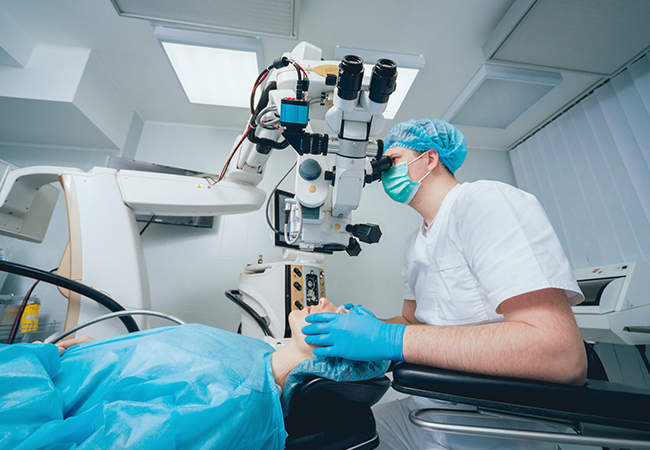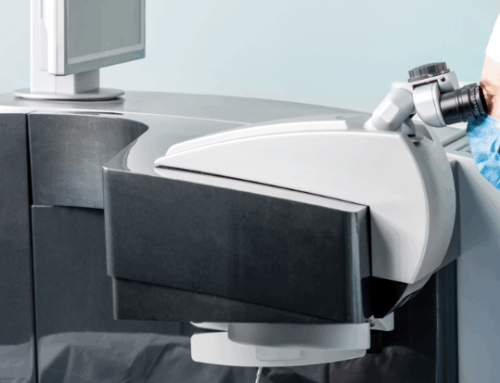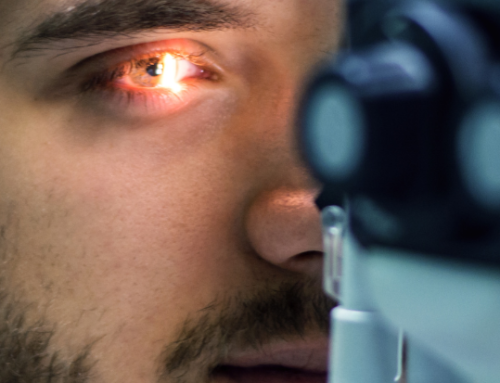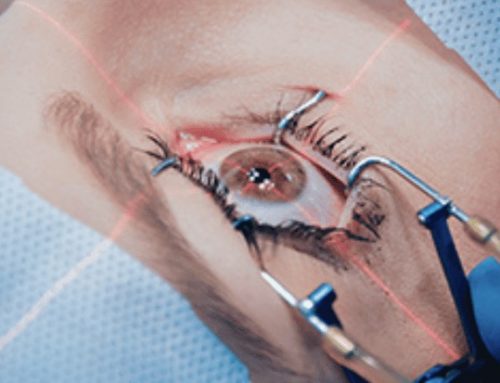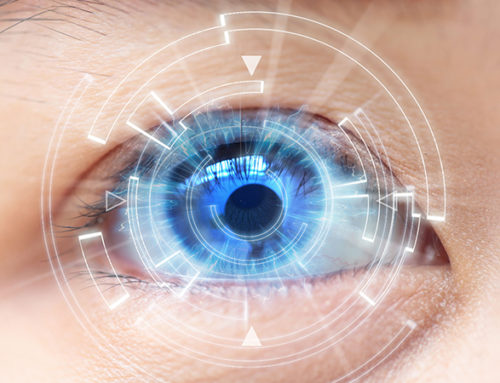Have you ever thought about a life without glasses? It is now possible with refractive surgery. This operation is performed using several advanced microsurgical techniques to correct the ametropic eye (myopic, hyperopic, astigmatic or presbyopic). What is refractive surgery? What are the different solutions available? What is the procedure for this operation? Find out everything you need to know about this operation.
Refractive surgery: what is it?
Refractive surgery is an ophthalmological operation that corrects the origin of visual problems by intervening on the eye itself. It consists of modifying the cornea (laser corrections) and/or implanting artificial lenses (implant surgery).
This operation brings together various interventions aimed at correcting certain refractive defects of the eye, in order to avoid having to resort to glasses or corrective lenses.
Since its inception, refractive surgery has made enormous progress thanks to advances in laser technology, so that it is now a common procedure, especially for myopia.
A team of ophthalmologists provides you with all the latest technologies for the diagnosis and treatment of visual anomalies. By choosing the method best suited to your needs.
Which visual disorders are affected by this surgery?
This treatment is aimed at anyone suffering from refractive disorders of the cornea (myopia, hyperopia, astigmatism, presbyopia). A priori, any person wearing glasses would be a candidate, but the evaluation is done on a case-by-case basis, by the surgeon according to the importance of the refractive disorder, and in particular the state of the cornea and the rest of the eye.
Correcting visual defects with refractive surgery
Most of these are refractive defects:
- Myopia: the eye is too long and the image of a distant object is focused in front of the retina. Distance vision is blurred, but the myopic eye sees clearly at close range.
- Hyperopia: the eye is too short and the image of a distant object is formed behind the retina. The hyperopic eye is usually able to see clearly at a distance, but not at close range.
- Astigmatism: the curvature of the cornea has an irregular shape: light rays focus on different points in front of and behind the retina. Astigmatism is often perceived by the person as blurred vision.
- Presbyopia: with age, from the age of 45 onwards, the lens has more difficulty in accommodating for near vision. Presbyopia particularly hinders reading
What are the different surgical techniques applied?
Laser surgical technique
There are three main surgical techniques that can be applied depending on your case. Depending on your particular situation, your ophthalmologist will suggest the one best suited to your needs.
The SMILE
A new SMILE technique modifies the cornea using a femto-second laser, avoiding the need to cut a cap. The SMILE technology can treat myopia simultaneously. Smile does not yet correct astigmatism and visual recovery can take 3-4 days longer than with LASIK.
Femto-LASIK
The Femto-Lasik technique is the most commonly used. In less than ten seconds per eye, a corneal flap (of about 100 µm) is created with the laser. Once this flap is lifted, the laser polishes the cornea with extreme precision.
It takes less than two seconds to correct a myopic defect of one diopter of myopia. An infrared camera coupled to the laser ensures the centring of the polishing even in the presence of micro eye movements. The LASIK technique is painless and allows the patient to resume normal activity the day after the operation.
This process combines two types of lasers:
- The femto-laser, which allows the eye to be prepared by cutting a "flap" in the surface layer of the cornea
- The so-called "excimer" laser, with cold light, which reshapes the curvature of the cornea.
This device corrects myopia up to approximately -10 dioptres, hyperopia up to +4 dioptres and astigmatism up to -4 dioptres.
The Trans-PRK
With this (older) technique, it is possible to correct myopia up to -7 dioptres, hyperopia up to +3 dioptres and astigmatism up to -3 dioptres.
Recovery is slower than with Femto-LASIK, but the long-term results are identical. The PRK technique is indicated when the cornea is too thin or in case of risky sports activities. The corneal epithelium (surface layer of the cornea) is removed mechanically. The cornea is then polished with the excimer laser. After the operation, it will take an average of one week to resume normal activity.
At CNVO, the "smart surf" "no touch all laser" technology is promoted, which is a modern trans-PRK.
Your ophthalmologist will work with you to determine the most suitable method for you.
Implant surgery
This surgery consists of inserting an artificial lens adapted to the vision defect of the eye and located between the iris and the crystalline lens. This implant can be removed or replaced at any time if necessary.
The surgeon ophthalmologist starts by making a small 3 mm opening at the edge of your cornea. He or she then inserts the folded lens into the eye through this opening and places it behind the iris where it unfolds by itself.
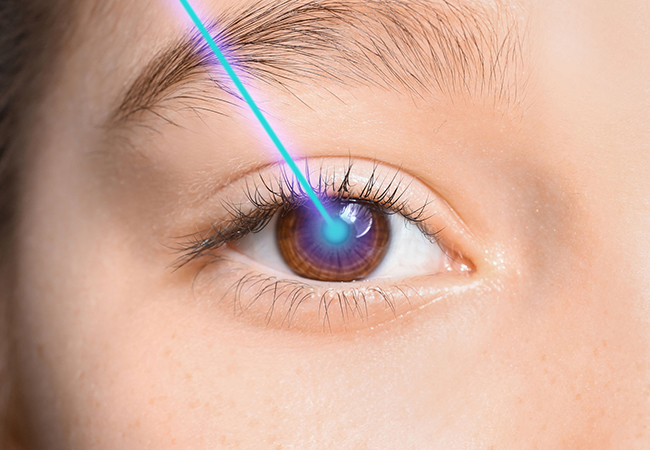
What is the procedure for refractive surgery?
In principle, the patient should not wear lenses for at least 48 hours before the operation, to allow the ocular surface to remain free of irritation on the day of the surgery.
The operation is performed by an expert surgeon , specially trained in refractive surgery techniques. Generally, both eyes are operated on in one operation (bilateral surgery).
Refractive surgery is performed on an outpatient basis, under local anaesthetic using eye drops, possibly supplemented by a mild tranquilliser. The procedure is painless. The patient lies down and a specific device called a blepharostat is put in place to hold the eyelids apart. During the procedure, the patient has to stare at a point of light.
The surgeon then proceeds with the chosen technique. Everything is computer-controlled to minimise intraoperative risks. Modern lasers are equipped with an eye tracking system or eye tracker, which allows the laser delivery system to follow the eye, even if it moves a little during the surgery.
The procedure takes 10 to 15 minutes per eye, but the laser itself takes only a few seconds. At the end of a PRK procedure, a "bandage" lens is placed on the eye.
What about post-operative follow-up?
After the operation, the patient is accompanied home in the evening. It is not advisable to drive after the operation. Antibiotic and anti-inflammatory eye drops are prescribed for about 3 weeks.
After any excimer laser surgery, it is indeed necessary to wear UV filtering glasses in case of sun exposure. Swimming is not recommended for a fortnight.
After PRK surgery, the epithelium grows back to cover the surface of the cornea within a few days. In the meantime, it is usual to experience some eye discomfort or even pain (which usually subsides within 24 hours).
It is best to allow a few days off work. Wearing a special lens helps to promote healing and limit pain, while taking painkillers.
After a Lasik operation, the postoperative period is simpler and less painful because the superficial epithelial layer is preserved thanks to the cutting of the cap.
A slight haze may persist for a few days but visual recovery is rapid and it is usually possible to resume activity the next day. It is very important not to rub the eyes during the first 24 hours.
Refractive surgery at the North Vaud Ophthalmology Centre
Centre Nord Vaudois d’Ophtalmologie is able to offer you refractive surgery. Our ophthalmological centre differs from other practices in that it provides personalised care and support for each patient, and has specific experience and know-how in the field of refractive surgery.
Dr. Michael Martin has over 15 years of experience. He is an FMH specialist in Ophthalmology and Ophthalmic Surgery and is always up to date with the latest scientific knowledge. He will provide you with excellent care, adapted to your specific problem.
We are pleased to welcome you to the Ophthalmology Centre in Yverdon.


